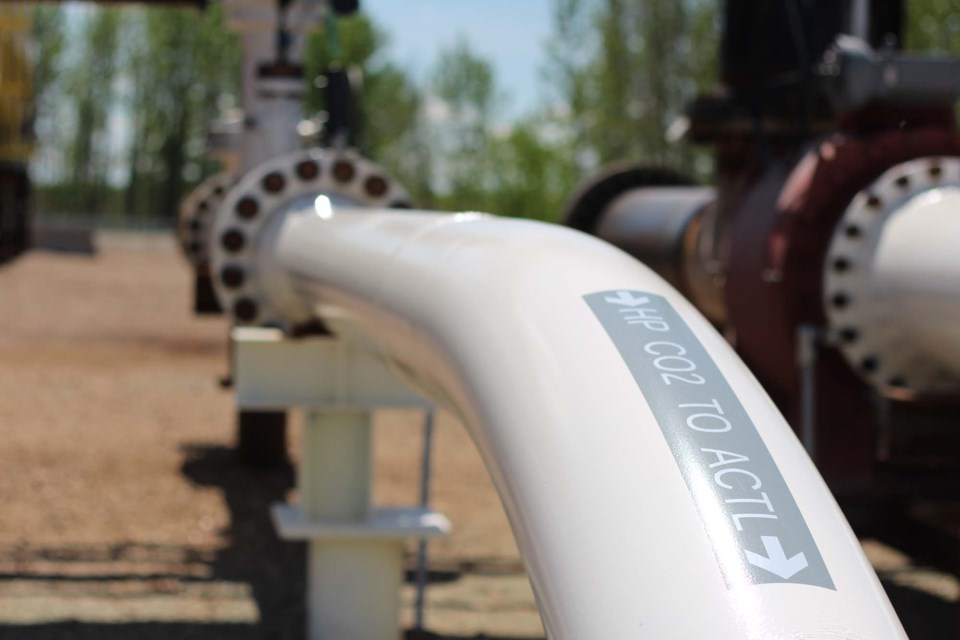Alberta is now home to the world’s biggest carbon storage pipeline, and it’s helping the Sturgeon Refinery do more to stop global heating.
The Alberta Carbon Trunk Line was declared fully operational on June 2.
Billed as the world’s largest capacity pipeline for human-made CO2, this $1.2-billion project has been in the works for about a decade and is backed by the federal and provincial government. It takes CO2 from the Sturgeon Refinery and the Nutrien fertilizer plant in Sturgeon County and injects it into the Clive oilfield 240 km to the south, trapping the gas underground while forcing more oil to the surface.
“Hydrocarbon fuels are here to stay for many, many years, yet we also have to figure out ways to make them have a much lower carbon intensity,” said Kerry Margetts, president of the Sturgeon Refinery.
Margetts said the refinery has been sending about 70 per cent of its CO2 emissions down the pipeline for the last few weeks and now and expects to trap about 1.3 megatonnes of that planet-warming gas a year (equivalent to 7,149 railcars of coal) underground. That means lower-carbon diesel from the refinery, which could give it a market edge.
CEO Kevin Jabusch of Enhance Energy, the lead partner on the trunk-line project, said the pipeline was currently carrying about 1.8 megatonnes of CO2 a year and could handle 14.6 – roughly 20 per cent of all current emissions from the oilsands. Gas from the line will help Enhance get about 30 more years worth of oil out of the Clive field.
It’s not a carbon-neutral system yet, Jabusch acknowledged in an interview, as you still release more carbon than you store when you burn that oil. Still, that oil was about 60 per cent less polluting in terms of carbon than conventional oil, and he hoped to eventually make it carbon-neutral as the system becomes more efficient.
“This will change how business is done in Alberta,” Jabusch said in a press release.
“We are putting CO2 to use. We permanently keep CO2 out of the environment while producing low-carbon energy.”
In an email, Sturgeon County Mayor Alanna Hnatiw said this project shows that industry can meet the world’s dual demands for fossil fuels and greener energy while creating opportunities for value-added products.
“This is a tremendous milestone in the energy value chain that will continue to play an important role in leading the world to a lower-carbon future,” Hnatiw said.
Important applications
Jason Switzer of the Alberta Clean Technology Industry Alliance said the Alberta Trunk Line was part of the emerging carbon-capture industry. Carbon capture is seen as an important part of the global heating solution, as it’s one of the few ways industries such as steel, cement, and fertilizer can shrink their carbon footprint.
Alberta and Saskatchewan have about 330 gigatonnes of storage capacity they could use if they can figure out a way to make money off carbon capture, Switzer said. One method was enhanced oil recovery, which is what Enhance is doing. Done properly, enhanced oil recovery can store more carbon underground than is released by the oil it sends back up.
Switzer said this pipeline could be the start of a new industrial cluster in Sturgeon, one that would take carbon produced by the Sturgeon Refinery and turn it into products such as carbon nanotubes or soap.
Jabusch said the pipeline has excess capacity and could expand to other oilfields once the current one fills up. Pretty much every facility in the Alberta Industrial Heartland could hook into it.
“There’s a lot of interest in decarbonising both the oil business as well as other industries like fertilizers and chemicals,” he noted.
“The Carbon Trunk Line provides the pathway to make that a reality.”
Visit actl.ca for details on the project.




